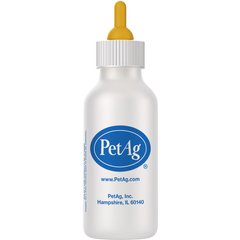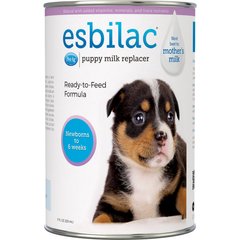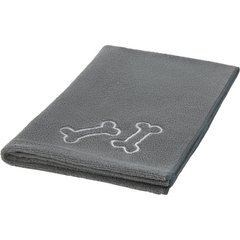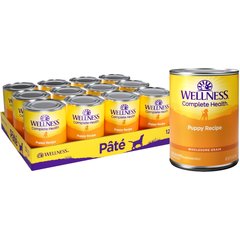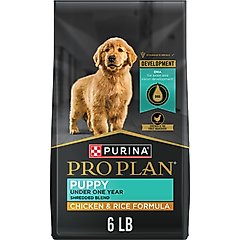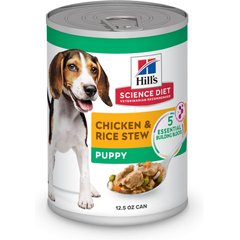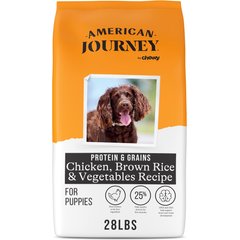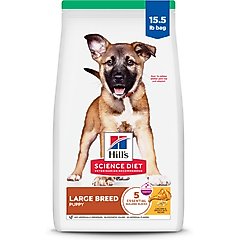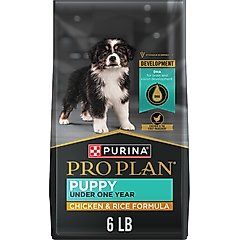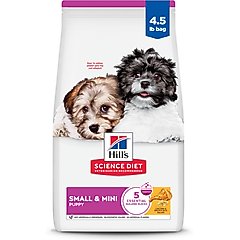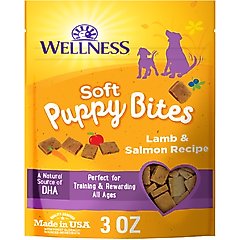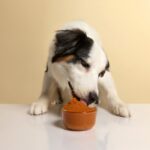Puppy Feeding Guide: How Much to Feed a Puppy
While it’s always important to feed your dogs well, it’s especially important to know how much to feed a puppy, so they can get the best start in life with the proper nutrition.
Your puppy’s growing bones, muscles, brain cells, and tissues require specific nutrients. Too few or too many calories, over-supplementing, or nutrient deficiencies can all be harmful to your pup in the long run, making it vital to know how much to feed a puppy and what type of food is best for them.
If you’re the caregiver of a new puppy, take a look through our guide to understand your puppy’s nutritional needs through every stage of their young life so you can help them thrive.
Key Takeaways
- Puppies need nutrient-rich food formulated for growth and development.
- The number of daily meals depends on your puppy’s age, with younger pups needing more frequent feedings.
- Portion sizes should be based on your puppy’s breed, size, and energy.
- Transition to adult food when your puppy is between 9 and 12 months old; your vet can give you precise guidance.
- Always provide access to fresh water and avoid feeding your puppy human food.
What Can Puppies Eat?
The best food for your puppy’s first month of life is their mother’s milk, which has the best balance of nutrients for a growing puppy.
If you are raising puppies yourself without the mother, or you need to supplement puppies for another reason, a formula specifically made for puppies is the best option. (Don’t substitute a kitten or human formula.)
Puppies should be weighed daily. While a pup may not gain weight the first day (a healthy starting weight is different for each breed and can be determined by your veterinarian), there should be steady weight gain after that.
If a puppy loses weight or fails to gain weight, contact your veterinarian.
How To Bottle-Feed Puppies
Whenever possible, puppies should be nursed and raised by their mothers. There are times, however, when bottle-feeding puppies becomes necessary.
“A large litter born to a mother with poor milk flow may require intervention,” says Richard Patton, a PhD animal nutritionist in Santa Fe, New Mexico. Bottle-feeding may also be required for puppies who are orphaned or rejected by their mothers.
Bottle-feeding the wrong product, the wrong way, in the wrong amount, or on the wrong schedule can lead to illness or even death. To start, you’ll need a puppy milk replacer, several pet nurser bottles, and a variety of nipples.
Recommended Products
Here’s how to bottle-feed puppies:
- Reconstitute powdered milk replacer per label instructions or use a premixed variety.
- Warm the bottle by placing it in a cup of hot water until the milk reaches body temperature (around 100 degrees Fahrenheit (38 degrees Celsius).
- Test the nipple before every feeding; it should only release a single drop of formula at a time.
- Place the pup belly-down on your lap or on a towel on a table, and insert the nipple into their mouth.
Recommended Product
- Tilt the bottle so that any air inside stays away from the nipple.
- Gently squeeze the bottle to release a drop of formula if the puppy is resistant at first.
- Continue feeding until the puppy’s suckling stops or slows dramatically. Gently put a finger against the puppy’s throat to feel if they are still swallowing.
- After feeding, use a warm, wet washcloth to gently wipe the area around the puppy’s anus or vulva. This is necessary to stimulate them to urinate and defecate.
Newborn puppies need to eat every two to three hours, but as long as they get four to five full meals throughout the day, nighttime feedings are generally not necessary. A two- to four-week-old puppy feeding schedule should consist of feedings every six to eight hours.
It usually isn’t necessary to determine exactly how much puppies are eating, as long as they gain weight daily and don’t cry for food between scheduled feedings. If you have questions or concerns, talk to your veterinarian.
When Can Puppies Eat Wet Food?
“Puppies can start to nibble food as early as three weeks,” says Dr. Patton, “but most tend to ignore it if their mother’s milk is sufficient.”
If you want to start weaning your puppies, wet puppy food is ideal because it’s soft enough that it doesn’t require much chewing. Once puppies begin to develop teeth, you can introduce kibble—but it should still be softened with water or milk replacer.
Weaning puppies should only be offered commercial dog food formulated specifically for puppies. The best puppy foods contain the ideal balance of nutrients puppies need while they’re still growing and developing.
Recommended Product
How To Wean Puppies
According to Dr. Patton, puppies are generally weaned at around six weeks of age. Some puppies may show an interest in solid food as early as three to four weeks, but you should wait to introduce it until the puppy begins to develop teeth.
Weaning should be a gradual process that takes place over several weeks. For example, at three to four weeks, puppies might only sniff at or lightly sample solid food. A five-week-old puppy feeding schedule should include increasing amounts of solid food as you gradually taper off the milk replacer.
Here are some tips for what to feed weaning puppies and how to do it:
- Use a nutritionally complete commercially made puppy food. Kibble should be softened with water or broth to a soupy texture, or you can add a little extra water to wet puppy food.
Recommended Products
- To get the puppies interested, dip your finger into the mush and then let them lick it. Puppies quickly learn to lap up the food.
- With multiple puppies, make sure each pup is getting their fair share. Supervised feedings with separate bowls for each puppy are recommended.
- Weigh puppies daily as a guideline for how much to feed; they should be growing at a steady but not excessive rate.
When it comes to weaning, your puppy feeding schedule may differ depending on the puppy’s breed size and rate of development.
Dr. Patton says a mother’s milk will continue to flow during weaning but in a diminishing amount. Three to four daily meals are sufficient for many puppies who are almost weaned but still nursing a little bit. However, toy- and small-breed pups may need extra snacks, as they are susceptible to hypoglycemia (low blood sugar).
Nutritional weaning is complete when the puppies are eating only puppy food and no longer nursing. When litters and moms are kept together, this usually occurs around seven to eight weeks of age.
How Much To Feed a Puppy
How much food you serve your puppy depends on their age, weight, and body condition score. Your dog’s body condition score measures their body fat, similar to body mass index (BMI) in humans, and is best determined by your vet.
Use these charts to find an average amount of calories your dog should consume—but remember that your pup may need up to 50% more or fewer calories, depending on their body condition score. Talk to your veterinarian for recommendations for your unique pup.
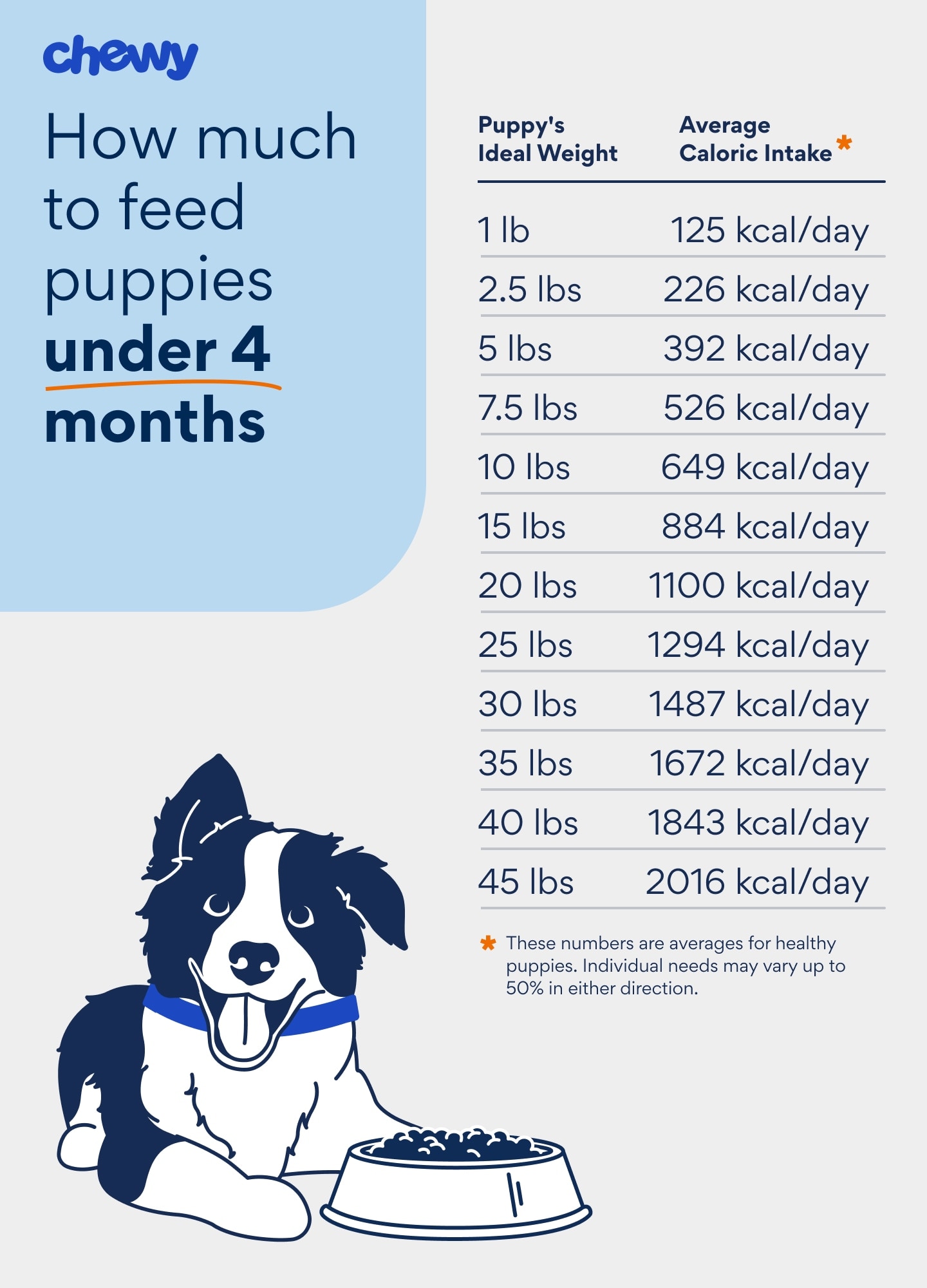
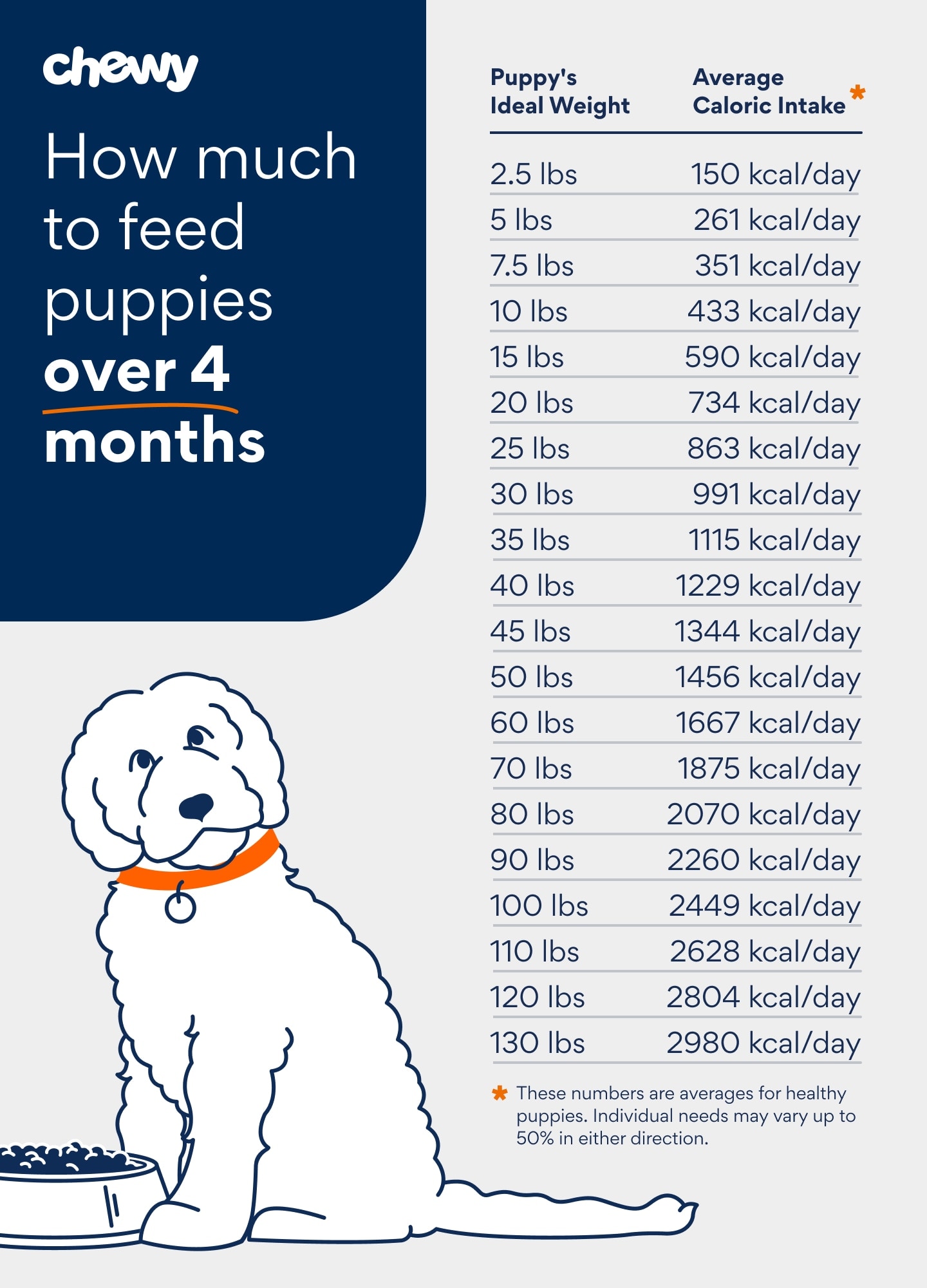
Not great at math? Don’t worry. The packaging for your pup’s dog food will have suggested feeding amounts.
It is extremely important that you follow the puppy feeding chart on your brand of puppy food, as well as the advice of your veterinarian. Your vet will make specific recommendations based on whether your pup is over or underweight; has nutritional deficiencies; is spayed or neutered; and on their activity level and other factors—all of which will affect the recommended feeding amount for puppies.
Additionally, different puppy foods all have different nutrient densities, so manufacturers’ recommendations will vary from formula to formula. For example, this is American Journey Active Life Formula Puppy Chicken, Brown Rice & Vegetables Recipe Dog Food‘s feeding chart for puppies:
Recommended Product
| Weight | Cups (ages 1.5–6 mo.) | Cups (6 mo.–1 yr) |
|---|---|---|
| 3 lbs. | 3/4 | 1/2 |
| 6 lbs. | 1 1/4 | 3/4 |
| 10 lbs. | 1 3/4 | 1 1/4 |
| 15 lbs. | 2 1/2 | 1 2/3 |
| 20 lbs. | 3 | 2 |
| 30 lbs. | 4 | 2 3/4 |
| 40 lbs. | 5 | 3 1/3 |
| 50 lbs. | 6 | 4 |
| 60 lbs. | 6 3/4 | 4 2/3 |
| 70 lbs. | 7 2/3 | 5 1/4 |
| 80 lbs. | 8 1/2 | 5 2/3 |
Different brands’ pup feeding guidelines will look different, due to the varying amount of ingredients and nutrients in each formula. Again, it is extremely important that you follow the feeding chart for puppies that your specific puppy food provides. Otherwise, you may be overfeeding or underfeeding your pup.
Another important note when it comes to how much do you feed puppies: Use something to accurately measure the food, like a scale for weighing out portions or a measuring cup.
The Best Puppy Food
When you compare a puppy food to an adult dog food, you will notice differences. Guidelines established by the Association of American Feed Control Officials (AAFCO) require more of almost every nutrient for puppy food versus adult food.
Puppy food will also contain a different balance of calcium and phosphorus when contrasted with adult dog food to allow a puppy’s bones to grow at an appropriate rate (not too fast, not too slow).
As for the type of food to feed your puppy, you can feed solid food or wet food—or both! There are many benefits of mixing wet and dry pet food: It can increase palatability, increase water intake (and a hydrated dog is a happy dog!), and help with weight management.
Try these vet-recommended dry and wet foods for puppies:
Dog Food for Large- and Giant-Breed Puppies
Some companies have developed formulas for different groups of puppies. Food for large- and giant-breed puppies needs to have the perfect amount of calories, protein, calcium, and phosphorus to establish a slow but steady growth and avoid orthopedic problems. (You don’t want your Great Dane to grow too fast.) Many large- and giant-breed dogs don’t reach adult size until they are well over a year of age.
Recommended Products
Dog Food for Small- and Toy-Breed Puppies
Small- and toy-breed dogs reach mature size more quickly and can’t physically eat large amounts of food, so pet parents should opt for a nutrient-dense small breed puppy food.
Recommended Product
Treats for Puppies
Treats are an inevitable part of pup feeding. Limit puppy treats to 10% or less of their diet, otherwise you may go beyond how much a puppy should eat. Stick to healthy dog treats made for puppies or training treats (and no table scraps!).
Recommended Product
Puppy Feeding Schedule
How often should you feed your puppy? When it comes to daily feeding, don’t fall into the trap of always leaving food down; this can increase your puppy’s chances of overeating. (Your dog should always have access to fresh water up to an hour or two before bedtime, however.)
Feed your puppy the specified quantities set by your vet and your puppy’s food label at mealtimes, so you know exactly when your puppy last ate and how much.
Most puppies do best with three meals a day until six months of age, then switching over to two meals a day.
For toy- and small-breed dogs, four meals a day until six months of age, then three meals a day may be best.
Ask your vet about a specific feeding schedule to ensure you’re meeting your dog’s unique needs.
When Can a Puppy Eat Adult Food?
How long you feed puppy food before switching to an adult diet depends largely on genetic factors such as breed size.
Puppies are generally ready for adult food when they reach 80% of their adult size.
- Small breeds (under 25 pounds at adulthood), usually reach this size around 10–12 months of age.
- Medium breeds (25–50 pounds at adulthood), get there around 12–15 months of age.
- Large breeds (50 pounds and up at adulthood) typically reach this size between 15–24 months of age.
Monitoring your puppy’s weight throughout their development is key for determining how long to feed puppy food. If you’re not tracking your puppy’s weight at home, your vet will have a record of it from each checkup or vaccination appointment. They’ll also be able to assess your puppy’s body condition and determine if their skeleton has stopped growing.
Once your puppy is ready for an adult food, be sure to feed them a vet-recommended dog food that suits their breed size and specific nutritional needs.
Recommended Product
Human Foods for Puppies
The best thing to feed your puppy is nutritionally complete commercial puppy food. Human food isn’t properly balanced to meet your puppy’s needs; some human foods may upset your puppy’s sensitive digestion or cause a toxic reaction.
Once your puppy is fully weaned and their teeth have grown in, however, you may be able to introduce dog-safe human foods in small amounts. These are best reserved for occasional treats or used as high-value training rewards for puppies.
Puppy Feeding FAQs
What do I feed a puppy with coccidia?
Coccidiosis is an intestinal infection caused by a small single-celled organism called coccidia. Puppies infected with coccidia can show a range of clinical signs. Some are asymptomatic, with infection discovered on a routine fecal exam. Others may be more severely affected, showing signs of diarrhea (sometimes with blood), inappetence, lethargy, abdominal pain, and discomfort.
Treatment typically involves administration of a prescription antibiotic to rid the body of the organism. In severely affected puppies, more intensive care may be needed.
If the puppy is asymptomatic, they may continue to eat their normal puppy diet. Dietary changes may only be needed when the puppy has experienced significant digestive upset. In those cases, a bland, low-fat, easily digestible diet like Purina Pro Plan Puppy Sensitive Skin & Stomach Dry Dog Food may be recommended.
If the puppy has lost weight, a more calorie-dense diet may be used in the short term. The right diet will depend on how badly the puppy was infected and how their gut is recovering. Most puppies will be able to transition back to regular puppy food over time.
What do I feed a puppy with upset stomach?
There are many potential causes for upset stomach in puppies.
They love to explore their new environment through their mouths, which can lead to ingestion of non-food items causing stomach upset. Sudden vomiting and diarrhea may also be caused by a new food or treat; diet change; a blockage of the digestive tract; intestinal parasites; infections with bacteria or viruses; exposure to toxins; or disease affecting other organ systems.
Some cases are mild, while others can be severe to life-threatening. It’s best to work with your veterinarian to determine the cause for stomach upset in your puppy.
- In some cases, a bland diet lower in fat that is easily digestible may be recommended. (Try Purina Pro Plan Puppy Sensitive Skin & Stomach Dry Dog Food.) For sudden stomach upset due to simple causes, this can often help.
- Your vet may recommend a prescription diet, like Royal Canin Veterinary Diet Gastrointestinal Puppy Dry Dog Food, offered in smaller, more frequent meals for a few days.
- If digestive issues resolve, a gradual transition back to the regular puppy food diet can usually happen. A probiotic is sometimes prescribed to aid in digestion.
- If your veterinarian suspects food intolerance as a cause for continued stomach upset (or other signs), they may suggest trying a hypoallergenic diet, like Royal Canin Veterinary Diet Hydrolyzed Protein HP Dry Dog Food, or a diet with limited ingredients.
What do I feed a puppy with parvo?
Parvovirus infects the intestinal tract of puppies. It can lead to severe signs, including vomiting; diarrhea with blood; lethargy; inappetence; and abdominal discomfort.
Most puppies affected with parvovirus require intensive care in the hospital. Some may be amenable to outpatient care if their signs are mild.
Keeping up with the puppy’s hydration and nutritional requirements are key to managing their disease and helping them recover. This may be done in one of several ways during a hospital stay:
- Nutrition may be given through a feeding tube and in some cases through an intravenous catheter (parenteral nutrition).
- Some puppies may be amenable to small, frequent meals via syringe feeding.
- The puppy will likely be sent home with a prescription diet that is bland, low in fat, and easily digestible. Some may require a more calorie-dense, critical care recovery diet, such as Purina Pro Plan Veterinary Diets CN Critical Nutrition Formula Canned Dog & Cat Food.
- Once recovered, most can transition back to regular puppy food.
How many times a day should a dog eat?
Many dogs are fed twice daily. Your dog’s ideal meal frequency may vary depending on their age and calorie requirements. Growing puppies and working dogs, for example, may require a more frequent influx of calories and nutrients.
Toy and small breeds may also benefit from smaller, more frequent meals to prevent potentially dangerous drops in blood sugar. Some dogs may also have an individual preference to graze versus meal feed, so offering those dogs multiple, small meals throughout the day may be best. Your veterinarian can best determine how many times a day your dog should eat.
Additional reporting by Kate Barrington and Deb M. Eldredge, DVM.
Additional expert input provided by Christina Fernandez, DVM, DACVECC.
This content was medically reviewed by Hannah Hart, DVM, Chewy veterinarian.
